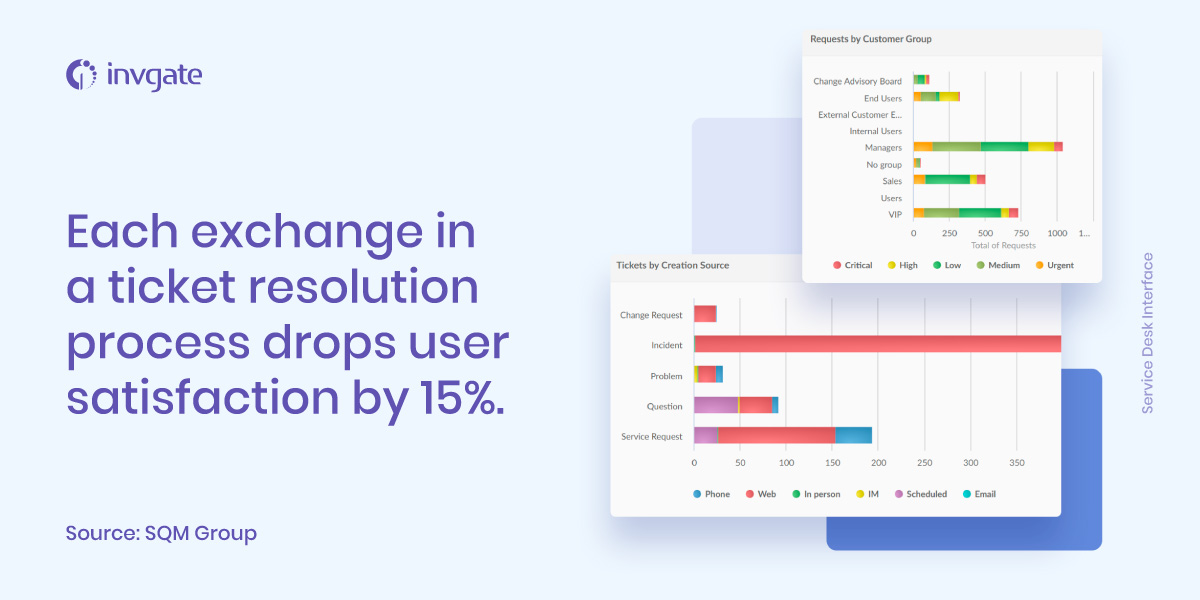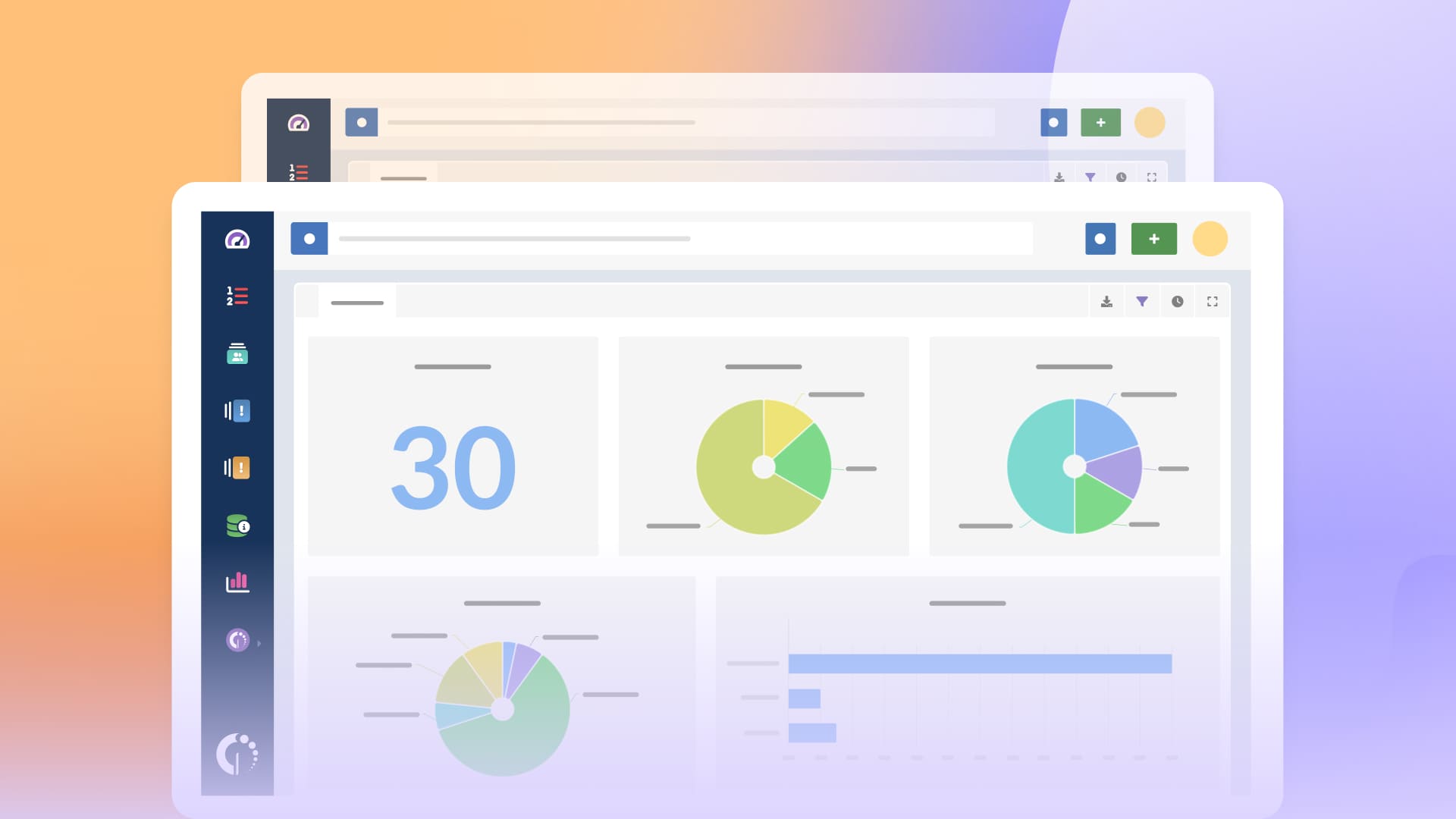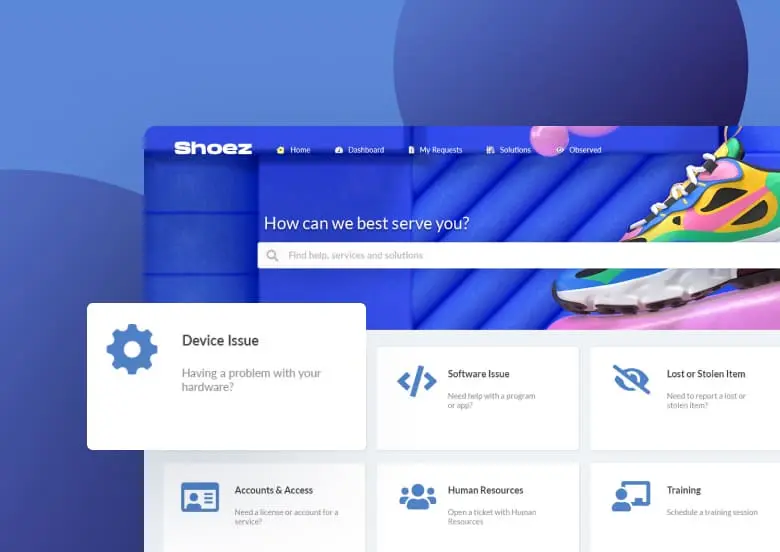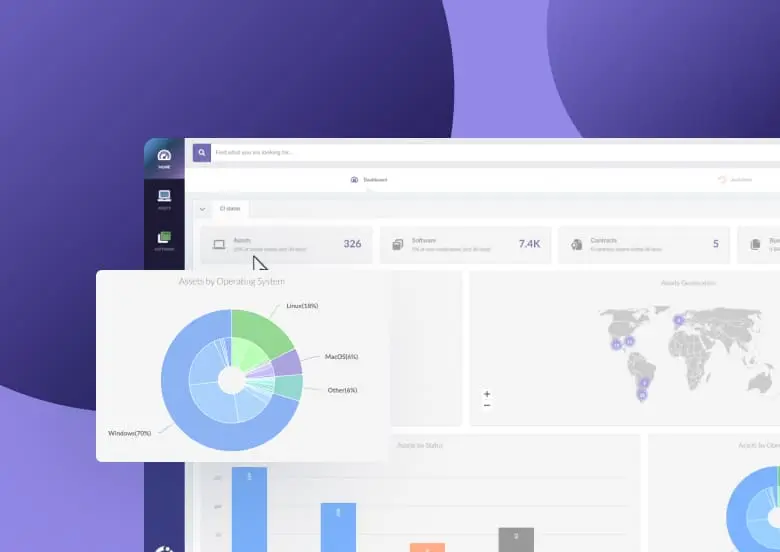Just as having help desk software is essential, so is measuring team performance. And the way to do that is through service desk KPIs. But which help desk metrics should you focus on for your team when there are so many to consider?
The answer isn't always clear or straightforward. And while it's true that metrics aren't everything — because numbers don't capture their context, such as the circumstances surrounding them — they can provide valuable insight into a current issue or help predict future problems.
When setting up a help desk KPI program for your IT support team, the most important thing to remember is that you're trying to improve efficiency, customer satisfaction, and output quality.
If you are looking for crucial service desk reporting metrics that will make your IT team shine, read on to find out!

What are help desk metrics?
Help desk metrics are quantifiable indicators that evaluate the performance and effectiveness of support teams. They can determine whether the teams are achieving their goals and providing satisfactory customer support services.
Service desk reporting metrics can vary depending on the specific goals of the team and the type of support delivered. In general, the purpose of a service desk is to provide IT support. However, some organizations use it more broadly to refer to a customer service, customer support, or customer advocacy team.
Help desk metrics vs. KPIs
Although their similarities, help desk metrics and Key Performance Indicators (KPIs) have different purposes and goals. Help desk metrics are specific, measurable parameters that contribute to the overall KPIs and tend to remain static. On the other hand, KPIs are broader, strategic measures linked to business goals and objectives. They focus on the organization's overall success, not just the support team's performance.
For example, Ticket Resolution Rate and Average Response Time (metrics) show whether the team is meeting its goal of increasing customer satisfaction for the quarter (KPI).

Why do you need proper service desk metrics?
When it comes to ITSM, a proper service desk performance report is your way of measuring real-world results. With anything related to IT, you’re not going to want to keep it abstract; rather, you’ll want to keep things as grounded and easy to follow as possible.
Therefore, metrics are going to help you assess whether different areas are working as they should and base business and management decisions on tangible information. We'll cover these in more depth, but just for now, let's say that you can measure things like:
- The speed at which users get support.
- Average ticket resolution speed.
- First contact resolution (FCR)
- Average tickets per user.
A sharp decrease in any of these numbers will indicate that not everything’s rosy with the way that your service desk is operating. Simple as that. Well, at least for now, because then it's time to assess what went wrong, why, and whether part of your IT department needs an overhaul. If things are going wrong on the human side, you may need to retrain or rehire positions; if things are going wrong with your service desk, it may be time to make some systems-wide upgrades.
5 benefits of tracking help desk KPIs
Monitoring help desk metrics benefits support teams and the organizations they serve. Some of these advantages include the following:
- Increases responsibility: When organizations clearly define and track KPIs, team members are likelier to take ownership of their work and strive to meet or exceed their goals.
- Improves customer satisfaction: By tracking help desk metrics such as First Response Time, Time to Resolution, and Customer Satisfaction, support teams can identify areas for improvement and take action to increase the customer experience. Improved customer satisfaction leads to higher customer loyalty and retention.
- Optimizes resource management: Monitoring Ticket Volume and Agent Productivity metrics help support agents allocate resources more effectively. These resources can include workforce levels, training and development programs, and technology investments. Better resource utilization leads to improved efficiency and cost savings.
- Aligns with business goals: Support teams can align their performance with the organization's overall goals. KPIs must be linked to business objectives so that teams can demonstrate their value to the organization and contribute to its success.
- Leads to data-driven decision-making: By keeping track of KPIs, support teams gain valuable information to make informed decisions about improving performance. They can identify trends, make predictions, and take action to optimize their processes and services.
A robust Service Desk solution should provide you with the necessary tools to cross-analyze the metrics we've been talking about. InvGate Service Management will offer a suite of reports that will allow you to analyze your service desk operational performance using over 150 built-in metrics.
Now, let's review the essential service desk metrics in detail:
15 help desk metrics to measure IT support performance
Measuring help desk metrics is essential to ensure support agents perform at their best. But which metrics should you track? Are all the metrics the same for every organization? (You’ll probably know the answer to the latter question).
Each organization should customize its metrics and focus on those that provide the most value. If you’re wondering how to start measuring your IT support performance, the first step is to group your help desk metrics into categories. The four types that stand out are:
- Productivity metrics: They evaluate the workload of your IT support or customer service team or individual agents, such as Ticket Volume, Ticket Backlog, and Agent Utilization.
- Quality metrics: They help you understand the impact you have on your customers, their impression of your brand, and their satisfaction levels — for example, Customer Satisfaction Score, Net Promoter Score, Service Level Agreement (SLA) Compliance, and Customer Effort Score.
- Performance metrics: They track the time it takes to resolve customer issues, such as First Response Time, First Contact Resolution, Time to Resolution, Average Handle Time, Escalation Rate, and Incident Severity.
- Financial metrics: They help you monitor the economic impact of your IT support operations — for example, Cost Per Ticket and ROI.

Productivity metrics
1. Ticket Volume
Ticket Volume (no, not our podcast) is the number of incidents or requests IT support receives and handles within a given period. It measures the workload and efficiency of the customer support team.
For example, suppose the volume of tickets is consistently high. In that case, it may indicate that the team needs more resources to handle the workload or that there are underlying issues causing a higher-than-average number of incidents or requests.
To calculate Ticket Volume, you need to track the number of tickets the support team receives over a specific period.
You’ll see this metric in your InvGate Service Management dashboard as “Total requests,” and you can filter them by status, priority, category, help desk, and more!
2. Ticket Backlog
Ticket Backlog measures the total number of tickets that agents have not resolved in a given period. It provides insights into the IT support staff's workload, the support system's efficiency, and customer satisfaction.
A high backlog can indicate that the IT support team is overwhelmed, leading to delayed resolution times and poor customer satisfaction. On the other hand, a low backlog can mean the team is efficient, leading to faster resolution times and higher customer satisfaction.
To calculate Ticket Backlog, you need to determine the number of open tickets at the beginning of a selected period and the number of closed tickets during the same period. The difference between the two will give you the ticket backlog at the end of the period.
For instance, if you had 50 open tickets at the beginning of the week and agents resolved 30 tickets, the backlog at the end of the week would be 20 tickets.
Fortunately, InvGate Service Management also calculates the ticket backlog for you! This metric is in your dashboard as “Requests (Backlog).” You can choose the date and also filter by conditions.
Providing a robust knowledge base or using automated workflows are great ways to deal with backlog issues. Remember that InvGate allows you to do both!
3. Agent Utilization
Agent Utilization measures the time an IT support agent spends on support-related activities compared to their total available work time.
Low agent utilization rates may indicate that the internal IT or customer support teams need to be more efficient. On the other hand, high agent utilization rates may show that support staff is overworked, leading to burnout and decreased quality of work.
To calculate agent utilization, you need to divide the total time an agent spent on support-related activities — on InvGate Service Management, you’ll find it as “Spent Time” — by their total available work time.
For example, if an agent spends 6 hours out of an 8-hour workday on support-related activities, their agent utilization rate would be 75%.

Dashboards vs. Reports: How to Get the Most out of Your ITSM Reporting Tools
Quality metrics
4. Customer Satisfaction Score (CSAT)
Customer Satisfaction Score measures how satisfied customers are with the IT support they receive.
The CSAT metric is typically measured by asking customers to rate their level of satisfaction with the IT support they received, usually on a scale of 1-5 or 1-10. CSAT provides valuable feedback on the quality of IT support services and helps identify areas for improvement. You should track CSAT regularly, ideally after each interaction with customers.
It is calculated by dividing the total score received by the total number of responses and multiplying it by 100 to get a percentage score.
For example, if you receive 100 responses with a total score of 400 out of a possible 500, the CSAT score would be 80% (400/500 x 100).
In your InvGate Service Management dashboard, you'll find the CSAT in Metrics - “Rating.” You can then add the filters that you need!
5. Net Promoter Score (NPS)
Net Promoter Score is the customers' likelihood of recommending a company or its products/services to others. It is a widely used metric that helps organizations understand customer loyalty and satisfaction. Moreover, organizations use it to compare the performance of different products or services and to evaluate the effectiveness of changes made to customer experience initiatives.
The NPS metric is typically measured by asking customers a single question: "On a scale of 0-10, how likely are you to recommend our company/products/services to a friend or colleague?" Based on their response, customers are then classified into three categories: Promoters (9-10), Passives (7-8), and Detractors (0-6).
To calculate the NPS, you subtract the percentage of Detractors from the percentage of Promoters. The Passives are not factored into the calculation. The resulting score can range from -100 to 100, with a higher score indicating a greater likelihood of customer advocacy and loyalty.
For example, if 60% of customers are Promoters, 20% are Passives, and 20% are Detractors, the NPS would be 40 (60 - 20).
6. Service Level Agreement (SLA) Compliance
Service Level Agreement Compliance measures the degree to which an IT support team meets the goals and standards outlined in their SLA. An SLA is a formal agreement between the IT support team and their customers, outlining the organization's services, the expected support level, and the timeframe for resolving issues.
SLA Compliance is worth tracking because it can directly impact customer satisfaction levels, loyalty, and the organization's overall reputation. Customers receiving the support promised in their SLA are more likely to be satisfied and loyal to the organization, leading to increased customer retention and revenue.
To calculate SLA compliance, divide the number of requests resolved within a specified period by the total number of requests made within the same specified time, and multiply the result by 100 to get a percentage.
For example, if users made 100 requests in a month and agents resolved 90 of them within the specified timeframe, the SLA compliance rate would be 90%.
If you want to add this metric to your InvGate Service Management ITSM report, you can select the “First response SLA” and the “Resolution SLA.” Depending on your needs, you can visualize the percentage, whether it has been met or expired, etc.

5 Service Level Agreement Metrics to Track Service Fulfillment
7. Customer Effort Score (CES)
Customer Effort Score measures the ease or difficulty of a customer's experience when interacting with an organization's support team. It assesses the customer's effort to resolve an issue or complete a transaction.
The Customer Effort Score metric is typically measured by asking customers a single question after interacting with the support team: "How much effort did you have to put forth to handle your request?" Customers are then asked to rate their experience from "very easy" to "very difficult."
To calculate the CES score, you add the total number of customers who rated their experience as "very easy" or "somewhat easy" and divide it by the total number of respondents. The resulting score can range from 0 to 100, with a higher score indicating a lower level of customer effort required.
For example, if 300 customers responded to the CES survey and 200 of them rated their experience as "very easy" or "somewhat easy," the CES score would be 67% (200/300 x 100).

Performance metrics
8. First Response Time (FRT)
First Response Time is the time it takes for an IT support team to respond to a customer's initial request for assistance. It is a key performance indicator used to evaluate IT support teams' responsiveness.
Customers who receive a timely response to their support request are more likely to be satisfied with their service and are more likely to remain loyal to the organization.
To calculate FRT, subtract the time at which the customer made the request from the time at which the support team responded. For example, if a customer submitted a support request at 10:00 am and the support team responded at 10:15 am, the FRT would be 15 minutes.
FRT only measures the time it takes for the support team to respond to the customer's initial request. It doesn’t track the time it takes to resolve the issue.
With InvGate Service Management, you don't have to crunch the numbers! To include this metric in your ITSM dashboard, simply select "First Response SLA.”
9. First Contact Resolution (FCR)
First Contact Resolution is the ability of an IT support team to resolve customer issues or requests during the customer's initial contact with the support team.
To calculate FCR, divide the number of support requests resolved during the initial contact by the total number of support requests received, and multiply by 100 to get a percentage.
For example, if an IT support team received 100 requests and resolved 80 of them during the initial contact, the FCR would be 80%.
10. Time to Resolution (TTR)
Time to Resolution is the amount of time it takes for an IT support team to resolve a customer issue. It measures the elapsed time between the customer's initial contact and the resolution of the issue.
To calculate TTR, subtract the time at which the customer made the request from the time at which the issue was resolved.
For example, if a customer submitted a support request at 10:00 a.m., the support team responded at 10:15 a.m., and the issue was resolved at 11:00 a.m., the TTR would be 1 hour.
To see this metric in your InvGate Service Management ITSM report, go to Dimensions >> Dates and drag and drop “Creation Date” and “Solution Date.” Then you can calculate how long it took to resolve the tickets.
TTR measures the entire time it takes to resolve the issue, including any follow-up contacts or escalations.
Long support ticket resolution times may mean:
- You’re understaffed, or there are performance issues you need to address.
- Your internal knowledge base, available resources, or digital guides are not up to snuff.
- Finally, your employees may not be marking solved tickets as solved. Worse, a ticket may have more than one owner, leading to duplicated work.
11. Average Handle Time (AHT)
Average Handle Time measures the average amount of time it takes for an IT support representative to handle a request, including the time spent talking to the customer and any associated tasks, such as research or documentation.
It's important to balance AHT with other metrics, such as Customer Satisfaction and First Contact Resolution Rate. For example, an IT support representative may be able to handle requests quickly. Still, if they don't provide effective solutions or customers are not satisfied with their interactions, AHT alone may not provide a complete picture of the quality of the IT support services.
To calculate the AHT, you must divide the total time spent handling inquiries or requests by the total number of tickets.
For example, if an IT support representative spent 600 minutes handling 100 requests, the AHT would be 6 minutes (600/100).
In your InvGate SD report, select the metrics “Requests” and “Spent Time” and add “Agent” to a column. Then, divide the time spent by the total number of requests, and you’ll obtain the AHT.
12. Escalation Rate
Escalation Rate is the percentage of requests escalated to higher support or management levels. It measures the frequency at which issues are unable to be resolved by the initial support team and require further intervention.
To obtain it, divide the number of support requests that are escalated by the total number of support requests received and multiply by 100 to get a percentage.
For example, if an IT support team received 100 support requests and 10 of them were escalated to higher levels of support, the escalation rate would be 10%.
To visualize the total of requests vs. the total of escalations in your InvGate Service Management report, you have to include the metrics “Requests” and “Assignments (Escalations).”
13. Incident Severity
Incident Severity measures the impact of an IT incident on the organization's operations, services, or customers. It categorizes incidents based on the level of disruption or impact they have on the business.
There are generally four levels of incident severity:
- Critical: Incidents that cause significant disruption or complete outage of a critical business process, system, or service and require immediate resolution.
- High: Incidents that cause moderate disruption to business processes or services and require timely resolution.
- Medium: Incidents that cause minor disruption and require resolution within a reasonable timeframe.
- Low: Incidents that cause minimal or no disruption and can be resolved routinely.
To assign a severity level to an incident, you have to base it on its impact and urgency. Meanwhile, to determine the impact, you can consider factors such as the number of users affected, the criticality of the system or service, and the potential impact on revenue. Meanwhile, to determine the urgency, you can consider the impact of the incident and how quickly it needs to be resolved. Urgency can be determined by asking questions such as:
- Is the issue preventing users from performing critical business functions?
- Is there a workaround available?
- What is the expected downtime if the issue is not resolved?
In your InvGate SD reports, you can select “Priority” to see how many tickets are critical, high, medium, and low.
Financial metrics
14. Cost Per Ticket
Cost Per Ticket measures the average cost of resolving an IT support ticket. It helps organizations understand the financial impact of their IT support processes and can inform decisions around resource allocation and efficiency.
It is especially useful when tracked over time, as it can provide insights into the effectiveness of process changes or technology investments. For example, if a new support tool or process is implemented and the cost per ticket decreases over time, it can be seen as a sign that the investment was successful.
To calculate it, divide the total cost of providing IT support in a given period, including salaries, software, hardware, and any other associated costs, by the total number of tickets resolved during that period. The resulting figure represents the average cost of resolving a single support ticket.
15. ROI
ROI stands for Return on Investment, which measures the efficiency of an investment. Organizations use it to evaluate the financial returns of investments in IT infrastructure, software, or other technology-related projects.
For example, suppose an organization invests in InvGate Service Management software that improves efficiency and reduces the Average Handle Time for support tickets. If the investment results in cost savings and increased productivity, these financial benefits can be quantified and compared to the initial investment cost to calculate the ROI.
Tracking ROI over time allows companies to determine whether the investment was successful and whether further investments in similar technology are warranted.
To calculate ROI, you have to divide the Net Profit by the Cost of Investment and multiply it by 100. Net Profit refers to the total amount of revenue generated by the investment minus the cost of the investment itself.
Automating reports with top service desk metrics on InvGate Service Management
The InvGate Service Management reporting feature is a powerful way to slice, dice, visualize, and store your most crucial performance information. What’s more, service desk KPI reports can be set up to be automatically generated and distributed regularly, eliminating the need for manual reporting by agents and managers.
To get started, click on the “Reports” menu, go to “Requests,” and create a new report. Then, select the metrics you want to include – and don't forget to specify a date range. Just like that, your report is ready!
Now, let's look at the most interesting part: automation. To generate and send reports automatically, click on the clock button to schedule them, and choose which email addresses you want to send them to and when (e.g., daily, weekly, monthly, and even customized). Voilà! You have your reports ready without wasting any time. They can also be shared with both licensed and unlicensed users.
Plus, don't forget that you can also customize your ITSM dashboard to keep track of your service desk performance in real time.
How to get started with measuring service desk performance
To effectively track and improve your service desk’s performance, you need a clear strategy for defining and monitoring key performance indicators (KPIs). You should set the right goals and use the right tools so your team can gain meaningful insights that drive better service. Here are four essential steps to get you started.
1. Define your KPIs based on business goals
The first step is deciding what you want to measure. Start by aligning your KPIs with your business objectives. Ask yourself, "What does success look like for our service desk?"
For instance, if customer satisfaction is your priority, include metrics like First-Call Resolution or Customer Satisfaction Score. If efficiency is your focus, track Average Response Time and Ticket Volume. These KPIs will act as benchmarks for your team’s performance and help identify areas for improvement.
2. Set up tracking methods for KPIs
Once your KPIs are established, you need a way to track them. Many organizations use help desk software, which automates data collection and generates reports on key metrics. You can also monitor these KPIs manually using spreadsheets or other tools, but automation ensures more accurate, up-to-date data. Be sure to track these metrics regularly—weekly or monthly, depending on your support volume—so you can spot trends and adjust as needed.
3. Train employees on KPI importance
Your team needs to understand how their performance impacts the KPIs. Provide clear training that explains what each metric measures and why it matters. For example, show how reducing response times or resolving tickets on the first call contributes to customer satisfaction. When employees know how their work aligns with KPIs, they’re more likely to focus on improving these areas.
4. Implement software solutions to monitor and improve performance
Help desk software is essential for real-time performance tracking. A tool like InvGate Service Management can automatically monitor ticket handling, response times, and technician efficiency.
Implementing this software is relatively straightforward—start by integrating it with your existing system, and configure it to track your predefined KPIs. Most platforms offer customizable dashboards and reporting features, making it easy to visualize and improve your team’s performance over time.
Key takeaways
Measuring IT support performance through help desk metrics is crucial for businesses to identify areas for improvement and make data-driven decisions.
If you wonder which metrics to concentrate on for your team, consider those that provide the most value. For example, you can divide metrics into productivity, quality, performance, and financial. By tracking them, you can:
- Evaluate the workload of your IT support team.
- Understand the impact on your customers.
- Track the time it takes to resolve customer issues.
- Monitor the economic impact of your IT support operations.
We know that delivering exceptional customer support is a top priority for you. But how efficiently are you measuring your support process KPIs?
And since it’s all about improvement, please don’t calculate them by hand! Use InvGate Service Management to do it for you – and receive automated reports periodically to boost your help desk performance. Explore its reporting capabilities with our live demo or ask for a 30-day free trial today!
Frequently Asked Questions
How do you measure the success of a help desk?
You can measure help desk success with key metrics, such as:
- Productivity metrics
- Quality metrics
- Performance metrics
- Financial metrics
How do you monitor service desk performance?
Monitoring the performance of service desks is essential to ensure that IT support teams meet SLAs and deliver the best possible customer experience. Here are some ways to do it:
- Define key performance indicators (KPIs): Establish KPIs that align with business objectives and measure the effectiveness of your service desk.
- Use help desk software: Help desk software, such as InvGate Service Management, can provide real-time insights into your service desk performance.
- Conduct regular customer satisfaction surveys: Conduct regular surveys to gather feedback on the service quality and identify areas for improvement.
- Monitor Ticket Response Times: Track how quickly agents resolve tickets and how long customers wait for a response.
- Track Ticket Volume: Monitoring Ticket Volume can help you understand the workload and demand on your service desk.
- Monitor technician performance: Keep track of how well technicians perform, including Ticket Closure Rate and Time to Resolution.
- Perform trend analysis: Analyze service desk performance over time to identify trends and patterns.
- Monitor SLAs: Track SLAs to ensure that your service desk meets agreed-upon response and resolution times. It can help you identify areas where you must improve and maintain compliance with contractual obligations.
What are the two most important metrics to measure for a support team?
The two most important metrics to measure for a support team will depend on the specific goals and objectives of the organization. Still, Customer Satisfaction and First Contact Resolution Rate are considered the most important metrics for a support team.
How do you set KPIs for technical support?
Setting KPIs for technical support requires carefully analyzing business goals and objectives and understanding the metrics most relevant to the specific organization. Here are some steps to help set KPIs for technical support:
- Determine the organization's overall goals and how technical support contributes to achieving them. For example, if the organization aims to provide excellent customer service, technical support KPIs should align with this objective.
- Determine the metrics that are most relevant to technical support, such as First Contact Resolution Rate, Average Response Time, Customer Satisfaction, and Ticket Volume. These metrics should align with the business goals identified in step 1.
- Determine the benchmarks for each metric by analyzing industry standards, historical data, and the organization's goals. It will help establish targets for the KPIs the support team should aim to achieve.
- Establish KPIs for technical support that are specific, measurable, attainable, relevant, and time-bound (SMART). For example, a KPI for customer satisfaction could be to achieve a score of 90% or higher on customer surveys, and a KPI for First Contact Resolution Rate could be to achieve a rate of 80% or higher.
- Once you establish them, communicate the KPIs to the support team and ensure they understand the importance of achieving them. It will help motivate the team and ensure everyone works towards the same goals.
- Regularly monitor and evaluate the KPIs to determine if the support team is meeting the targets. Analyze the data to identify areas for improvement and develop strategies to enhance technical support performance.
What are good support metrics?
Good support metrics will depend on your goals. First, you need to decide what you want to achieve with your IT support team, and then choose the right metrics to measure success. In doing so, make sure to mix productivity, quality, performance, and financial KPIs to have a complete overview.
What are help desk performance goals?
Help desk performance aims to measure the time it takes to resolve customer issues.
What are the three recommended KPI categories?
When measuring the service desk, you need productivity, quality, and performance metrics. In addition, we recommend adding financial metrics to have an overview of the economic impact of your IT support operations.
















